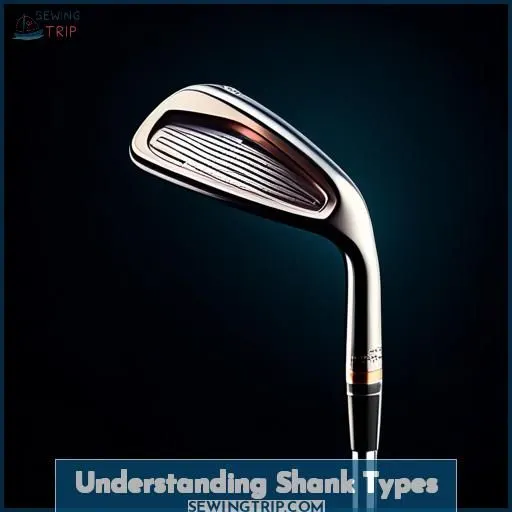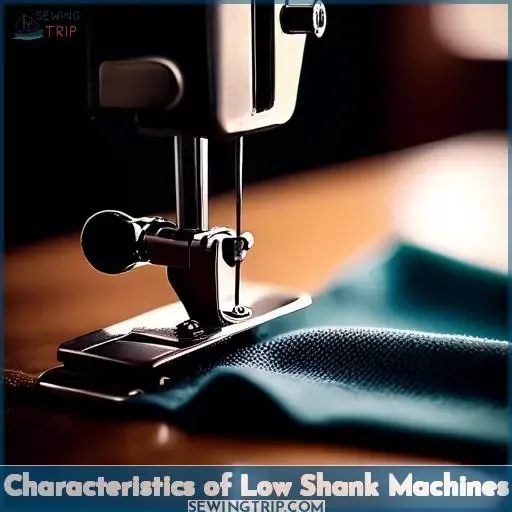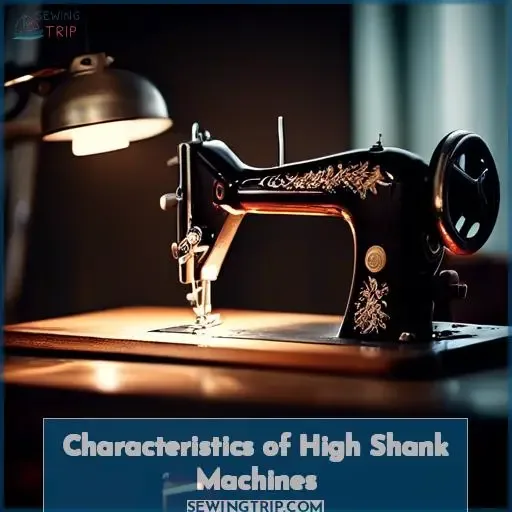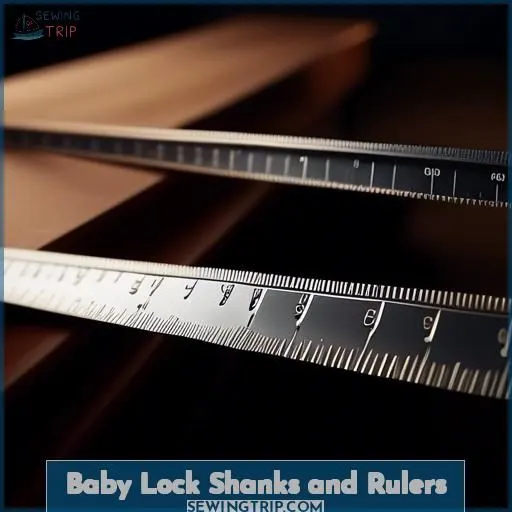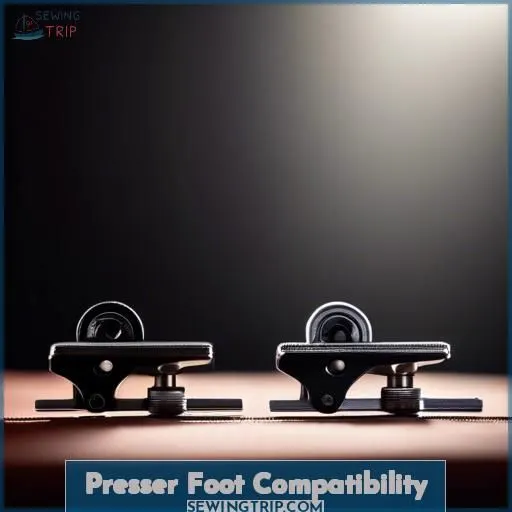This site is supported by our readers. We may earn a commission, at no cost to you, if you purchase through links.
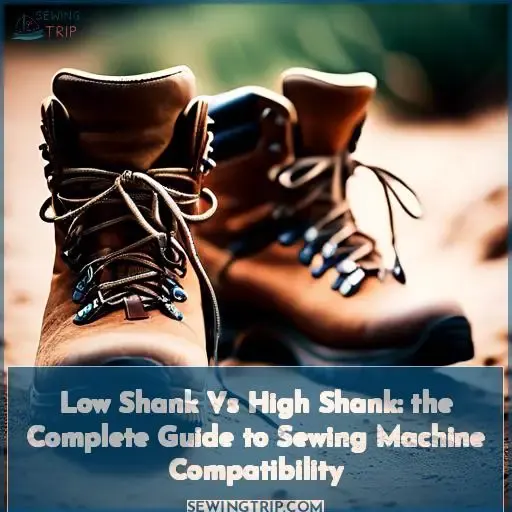 When comparing low shank vs. high shank sewing machines, you’ll notice distinct differences. Low shank machines, with a shank height of 3/4 inch or less, are ideal for lightweight fabrics like cottons and linens.
When comparing low shank vs. high shank sewing machines, you’ll notice distinct differences. Low shank machines, with a shank height of 3/4 inch or less, are ideal for lightweight fabrics like cottons and linens.
They’re common for home use but may require adapters for certain feet. High shank machines, at 1 inch or more, offer more power and throat space – perfect for heavy-duty projects with thick fabrics like denim or canvas.
Baby Lock provides rulers tailored to each shank type’s compatibility. Understanding these nuances helps ensure you choose the right feet and accessories to optimize your machine’s capabilities.
Table Of Contents
- Key Takeaways
- Understanding Shank Types
- Characteristics of Low Shank Machines
- Characteristics of High Shank Machines
- Baby Lock Shanks and Rulers
- Presser Foot Compatibility
- Snap-on Presser Feet Work on Both High and Low Shank Machines With a Snap-on System
- Screw-on Presser Feet Require a Low Shank Snap-on Adapter for Use on Low Shank Machines
- Bernina Sewing Machines Require a Bernina Adapter for Use With Universal Presser Feet
- Universal Screw-on Presser Feet Fit on Low Shank Sewing Machines
- Universal Screw-on Presser Feet Do Not Fit on High Shank Sewing Machines
- Frequently Asked Questions (FAQs)
- Conclusion
Key Takeaways
- Low shank machines are ideal for quilting cottons, linens, and lightweight canvases, while high shank machines are designed for thicker fabrics like denim and canvas.
- Low shank machines are more common on home sewing machines and may require an adapter for certain feet or tools, while high shank machines offer more throat space and power.
- To measure shank height, lower the presser foot and measure from the base of the foot to the center of the screw.
- High shank machines may have a specific clip-on system and may not be compatible with all rulers and presser feet, requiring adapter availability and power comparison for shank conversion.
Understanding Shank Types
First, you must understand the two types of shanks: low shank and high shank. Low shank machines have a shank height of 3/4 inch or less, while high shank machines have a shank height of 1 inch or more.
Low Shank Machines Have a Shank Height of 3/4 Inch or Less
Understanding shank types is crucial for ensuring machine compatibility and foot interchangeability.
Low shank machines have a shank height of 3/4 inch or less. They are ideal for quilting cottons, linens, and lightweight canvases. Low shank machines are more common on home sewing machines and may require an adapter for certain feet or tools.
High shank machines, on the other hand, are designed for thicker fabrics like denim and canvas. They offer more throat space and power. High shank machines are less common but may have a specific clip-on system.
Knowing the shank type is essential for selecting compatible feet and tools.
High Shank Machines Have a Shank Height of 1 Inch or More
High shank machines have a shank height of 1 inch or more, making them more suitable for thicker fabrics like denim and canvas.
They offer more throat space and power, which is less common but highly desirable for those who need to work with thicker materials.
However, this also means that high shank machines may require specific clip-on systems and may not be compatible with all rulers and presser feet.
Adapter availability is crucial for high shank compatibility, and power comparison is a key factor when considering shank conversion.
To Measure Shank Height, Lower the Presser Foot and Measure From the Base of the Foot to the Center of the Screw
To measure your sewing machine’s shank height, lower the presser foot and measure from the base of the foot to the center of the screw. This simple step ensures foot compatibility and adapter necessity for your machine.
Remember, foot replacement is crucial for machine adaptability and unlocking the secrets of sewing success.
Characteristics of Low Shank Machines
Low shank machines are ideal for quilting cottons, linens, and lightweight canvases. They’re more common on home sewing machines, but may require an adapter for certain feet or tools.
Ideal for Quilting Cottons, Linens, and Lightweight Canvases
Low shank machines are ideal for quilting cottons, linens, and lightweight canvases.
They’re more common on home sewing machines, but may require an adapter for certain feet or tools.
These machines offer less throat space and power compared to high shank machines.
High shank machines are designed for thicker fabrics like denim and canvas.
However, low shank machines are perfect for those who primarily work with lightweight fabrics and prefer a more compact sewing machine.
More Common on Home Sewing Machines
When it comes to home sewing, low shank machines are the most common type you’ll encounter. These machines are designed for a wide range of sewing tasks, making them versatile and suitable for various projects. They’re ideal for working with lightweight fabrics like quilting cottons, linens, and lightweight canvases. In fact, most domestic sewing machines fall into this category, as they’re built with the home sewer in mind.
One of the key features of low shank machines is their compatibility with a variety of feet and tools. However, they may require an adapter for certain feet or tools to work effectively. This is because low shank machines have a shank height of 3/4 inch or less, which is smaller than high shank machines.
In contrast, high shank machines are less common but offer more throat space and power. They’re designed for thicker fabrics like denim and canvas, and may have a specific clip-on system for attaching presser feet. High shank machines have a shank height of 1 inch or more, making them better suited for heavy-duty tasks.
Understanding the shank type of your sewing machine is crucial for selecting compatible feet and tools. Check the machine manual for specific details, as knowing the shank type can help you avoid frustration and ensure your projects turn out as intended.
May Require an Adapter for Certain Feet or Tools
You’ll find that your trusty low shank sewing machine might play a bit hard to get with some presser feet, demanding an adapter to bridge compatibility gaps.
It’s a small hiccup in the grand sewing adventure, ensuring you’re not left high and dry when facing interchangeability issues.
Think of it as a golden key, unlocking the full potential of presser feet availability, despite low shank limitations.
Characteristics of High Shank Machines
High shank machines are designed to handle thicker fabrics like denim and canvas. They offer more throat space and power, making them ideal for heavy-duty sewing projects.
Designed for Thicker Fabrics Like Denim and Canvas
High shank machines are designed for thicker fabrics like denim and canvas. They offer more throat space and power, making them less common but highly sought after.
- Fabric Types: Capable of handling thicker fabrics that low shank machines struggle with.
- Thread Tension: Adjustable to accommodate the increased thickness and weight of the fabric.
- Needle Size: Larger needles may be required for thicker fabrics to prevent damage.
These machines aren’t only designed to enhance your sewing experience but also to tackle larger projects with ease.
Less Common but Offer More Throat Space and Power
High shank machines are less common but offer more throat space and power, making them ideal for thick fabrics like denim and canvas.
They’re designed for power sewing, perfect for quilting and other heavy-duty projects.
With a shank height of 1 inch or more, high shank machines can handle thicker materials with ease.
They may also have a specific clip-on system, making them more versatile for a range of sewing tasks.
May Have a Specific Clip-on System
High shank machines are designed for thicker fabrics.
They offer more throat space and power.
They may have a specific clip-on system, such as the Bernina adapter for universal feet.
This clip-on system is designed to enhance the sewing experience.
It’s not only a feature, but it underpins the functionality of these machines.
It’s not merely an accessory; it’s a part of the sewing experience.
It’s meticulously crafted to ensure seamless performance.
Baby Lock Shanks and Rulers
Baby Lock offers rulers for both low and high shank machines, with different thicknesses to match. Low shank rulers can be used on high shank machines with Baby Lock rulers, but not the other way around.
Baby Lock Rulers for Low Shank Machines Are 3/16 Thick
When it comes to Baby Lock rulers, the thickness of the ruler is crucial for compatibility with your sewing machine.
For low shank machines, the recommended thickness is 3/16 inches. This is a common size for rulers designed for these machines, and it allows for a stable and accurate quilting experience.
However, if you have a high shank machine, you’d need a ruler that’s ¼ inch thick to ensure proper fit and function.
It’s essential to match the thickness of the ruler to the shank type of your machine to achieve the best results in your quilting projects.
Baby Lock Rulers for High Shank Machines Are ¼ Thick
When it comes to Baby Lock machines, there are different ruler sets for high shank and low shank machines.
- Ruler Thickness: Baby Lock rulers for high shank machines are ¼ inch thick, while those for low shank machines are 3/16 inch thick.
- Compatibility: High shank rulers can be used on long arm machines, but low shank rulers can’t be used on high shank machines.
- Usage: Low shank rulers can be used on high shank machines with Baby Lock rulers, but high shank rulers can’t be used on low shank machines.
Low Shank Rulers Can Be Used on High Shank Machines With Baby Lock Rulers
If you’re a quilter or sewer, understanding the shank types of your machine is crucial for selecting compatible feet and tools. Low shank machines, which are more common, are ideal for quilting cottons, linens, and lightweight canvases. They measure 3/4 inch or less in shank height and are typically found on home sewing machines. High shank machines, on the other hand, are designed for thicker fabrics like denim and canvas. They measure 1 inch or more in shank height and are less common but offer more throat space and power.
When it comes to rulers, the shank type plays a significant role in compatibility. Baby Lock rulers, for example, are available in two thicknesses: 3/16 inch for low shank machines and ¼ inch for high shank machines. Low shank rulers can be used on high shank machines with Baby Lock rulers, but high shank rulers can’t be used on low shank machines.
If you’re using a Baby Lock machine, it’s essential to know the shank type to choose the right ruler. Baby Lock low shank rulers can be used on high shank machines and long arm machines, providing a value-added bonus. However, if you’re using a Westalee ruler, the low shank rulers are very thin, and there’s a risk of the ruler sliding under the foot, so you’ll need to use a ⅛ inch ruler instead.
High Shank Rulers Cannot Be Used on Low Shank Machines
When you’re diving into the fabric jungle, remember this: high shank rulers are the elephants—they’re too hefty for the low shank machines’ smaller habitats. With a thicker ruler thickness, they’re meant for the long arm machines’ vast savannas. Baby Lock rulers flexibly adapt, but without the right adapter, it’s a no-go on the shank measurement mismatch.
High Shank Rulers Can Be Used on Long Arm Machines
When it comes to long arm machines, high shank rulers can be a game-changer.
These rulers are designed for high shank machines. They can provide the precision and accuracy needed for larger projects.
They are not only designed to enhance your sewing experience. They can also unveil the secrets of the ever-evolving world of long arm machines.
A high shank ruler is not merely an accessory. It is a tool that can unlock the secrets of the realm of long arm sewing.
If you are navigating the complexities of long arm machines, high shank rulers are a must-have.
Presser Foot Compatibility
When it comes to presser foot compatibility, snap-on presser feet are versatile and work on both high and low shank machines with a snap-on system. However, screw-on presser feet require a low shank snap-on adapter for use on low shank machines.
Snap-on Presser Feet Work on Both High and Low Shank Machines With a Snap-on System
When it comes to sewing machine compatibility, one of the most important factors to consider is the shank type. There are two primary types of shanks: low shank and high shank. Low shank machines have a shank height of 3/4 inch or less, while high shank machines have a shank height of 1 inch or more. To measure shank height, lower the presser foot and measure from the base of the foot to the center of the screw.
Low shank machines are ideal for quilting cottons, linens, and lightweight canvases, and are more common on home sewing machines. High shank machines, on the other hand, are designed for thicker fabrics like denim and canvas, and offer more throat space and power. They’re less common but can be found on higher-end machines.
Snap-on presser feet work on both high and low shank machines with a snap-on system. This means that you can use the same snap-on feet on both types of machines, making it easier to switch between different tasks. However, it’s essential to ensure that your machine is compatible with snap-on feet, as some brands like Pfaff use a different snap-on system.
Screw-on Presser Feet Require a Low Shank Snap-on Adapter for Use on Low Shank Machines
If you’re using screw-on presser feet, you’ll need a trusty low shank snap-on adapter to ensure your machine plays nice with these handy helpers.
- Snap-on systems simplify attachment swaps—no fiddling with screws!
- Adapter availability means you’re never stuck without the right tool.
- Presser foot functionality expands your sewing horizons.
- Machine compatibility keeps your creative flow uninterrupted.
Bernina Sewing Machines Require a Bernina Adapter for Use With Universal Presser Feet
If you’re a Bernina sewing machine owner, you might’ve wondered how to use universal presser feet on your machine. Well, the solution lies in the Bernina adapter! This adapter allows your Bernina to be compatible with both universal clip-on feet and screw-on low shank feet, such as those designed for modern home sewing machines like Brother, Singer, Toyota, Janome, and more.
To use this adapter, you simply screw it onto your Bernina sewing machine. Once it’s attached, you can use the snap-on adapter that’s already screwed in place, or you can remove it and use screw-on regular sewing machine feet instead. This adapter is compatible with a wide range of Bernina models, including 530, 530-2, 531, 532, 532-2, 534, 540, 540-2, 542-2, 600 (Not Deco 600), 610, 614, 640 (Not Artista 640), 640-2, 642-2, 644, 700, 707, 708, 709, 717, 718, 719, 730 (Not Artista 730), 731, 732, 741, 742, 744, 800, Minimatic 801, 801s, 802, 802s, 803, 803s, 807, 808, 809, 810, 811, 811s, 817, 818, 819, 830, 830e, 830H, 831, 832, 840, 841, 842, 850, 900, 900E, 910, 910N, 930, 931, 932, 940, 950, 1000, 1001, 1004, 1005, 1006, 1008, 1010, 1011, 1020, 1030, 1031, 1080, 1090, 1120, 1130, 1230, 1260, 1530 & 1630.
Universal Screw-on Presser Feet Fit on Low Shank Sewing Machines
When it comes to using universal screw-on presser feet on low shank sewing machines, it’s a breeze.
These feet are designed to fit seamlessly onto low shank machines, making them a versatile choice for your sewing projects.
However, high shank machines require a different approach.
They may not be compatible with universal screw-on presser feet.
You might need a Bernina adapter to ensure compatibility with Bernina machines.
Universal Screw-on Presser Feet Do Not Fit on High Shank Sewing Machines
When it comes to sewing machine compatibility, understanding the difference between low shank and high shank machines is crucial.
Low shank machines, with a shank height of 3/4 inch or less, are ideal for quilting cottons, linens, and lightweight canvases.
High shank machines, on the other hand, are designed for thicker fabrics like denim and canvas.
However, not all presser feet are compatible with both shank types.
For instance, universal screw-on presser feet don’t fit on high shank sewing machines.
This is where adapters come in handy, allowing for interchangeability and versatility in fabric thickness.
Frequently Asked Questions (FAQs)
Can low shank presser feet be used on high shank machines?
You can sometimes use low shank presser feet on high shank machines if you get an adapter. But it’s best to use high shank feet made for your machine – they’re designed for the extra height and power.
How does one measure the shank height on a sewing machine?
Having the right tools avoids frustration. To measure shank height, lower the presser foot and measure from the foot’s base to the screw’s center. This determines compatibility for specialized sewing feet.
What is the difference between low and high shank machines in terms of fabric compatibility?
Low shank machines suit lightweight fabrics like cottons, while high shanks handle thicker materials like denim or canvas. Understanding your machine’s capabilities ensures proper fabric/foot pairings for optimal results.
Can high shank rulers be used on low shank machines?
No, you can’t use high shank rulers on low shank machines. The thick rulers won’t fit under the low shank foot properly. However, some brands like Baby Lock allow using their low shank rulers on high shanks – giving you versatility.
What are the benefits of using a high shank machine over a low shank one?
Picture a grand castle versus a quaint cottage – high shank machines offer more power, space to maneuver thick fabrics, and sturdy construction for heavy-duty sewing.
Conclusion
Selecting suitable shank types ensures seamless sewing sessions. Low shank machines excel with lightweight fabrics, while high shank tackle thicker textiles. Presser foot compatibility counts: screw-on feet fit low shanks, snap-ons suit both. Bernina requires branded adapters. Baby Lock rulers match respective shank heights. Comprehending these nuances maximizes your machine’s potential, propelling projects forward flawlessly.

